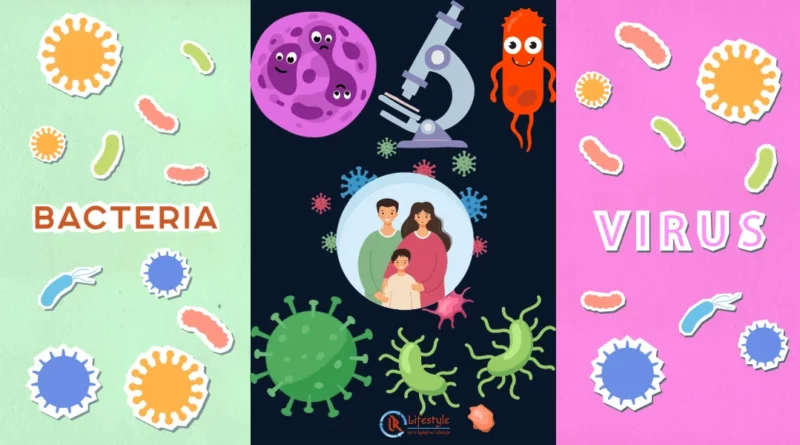Viruses and Bacteria: A Comprehensive Guide
Introduction
Viruses and bacteria are two of the most fundamental microorganisms on Earth, yet they exhibit distinct characteristics and play contrasting roles in our lives. Understanding these minute but mighty entities is essential not only for scientific curiosity but also for public health, agriculture, and various industries. In this comprehensive guide, we will delve into the world of viruses and bacteria, exploring their structure, function, classification, interactions with humans and the environment, and their critical roles in both disease and beneficial applications.
The Microbial World: An Overview
Definition of Microorganisms
Microorganisms, often referred to as microbes, are tiny living organisms that cannot be seen with the naked eye. They include a diverse range of life forms such as bacteria, viruses, fungi, protozoa, and archaea. Despite their small size, microorganisms are ubiquitous and play crucial roles in various ecosystems, industries, and human health.
Importance of Studying Viruses and Bacteria
The study of viruses and bacteria is paramount for several reasons:
Public Health: Understanding these microorganisms helps in combating infectious diseases, developing vaccines, and designing effective treatments.
Biotechnology: Bacteria are used in biotechnological processes like fermentation, while viruses are essential in gene therapy and molecular biology.
Environmental Impact: Microbes influence nutrient cycling, decomposition, and even climate regulation.
Industrial Applications: Bacteria are used in the production of enzymes, antibiotics, and biofuels.
Historical Perspective
The history of microbiology is intertwined with the discovery and understanding of viruses and bacteria. Early pioneers like Antonie van Leeuwenhoek, who invented the microscope, laid the foundation for the observation of these microorganisms. The late 19th and 20th centuries brought groundbreaking discoveries, including the isolation of viruses and the development of antibiotics. Today, ongoing research continues to expand our knowledge of these microorganisms.
Viruses: Nature’s Tiny Invaders
What Are Viruses?
Viruses are the smallest and simplest infectious agents. They are not classified as living organisms because they lack the cellular structure found in bacteria, fungi, and other life forms. Instead, viruses consist of genetic material (either DNA or RNA) enclosed in a protein coat called a capsid. Some viruses also have an outer lipid envelope.
Structure of Viruses
Viruses come in various shapes, including helical, icosahedral, and complex. The capsid encloses the genetic material, and the envelope, if present, is derived from the host cell membrane. The combination of genetic material and capsid is known as a virion.
Replication and Life Cycle
Viruses are obligate intracellular parasites, meaning they cannot replicate outside a host cell. Their replication involves attaching to a host cell, injecting their genetic material, and hijacking the host cell’s machinery to replicate and assemble new virions. This process often leads to cell lysis (bursting) and the release of new virus particles.
Types of Viruses
Viruses exhibit immense diversity and infect various life forms, including animals, plants, fungi, bacteria (bacteriophages), and even other viruses. They are classified based on their genetic material, replication strategy, and host specificity. Major viral groups include DNA viruses, RNA viruses, retroviruses, and more.
Viruses and Disease
Viruses are responsible for a wide range of diseases in humans, animals, and plants. Some well-known viral diseases include HIV/AIDS, influenza, COVID-19, and the common cold. Understanding viral pathogenesis is crucial for developing treatments and vaccines.
Bacteria: The Microscopic Powerhouses
Introduction to Bacteria
Bacteria are single-celled microorganisms that belong to the domain of life known as Bacteria. They are among the most ancient life forms on Earth and occupy virtually every habitat, from deep-sea hydrothermal vents to human intestines.
Bacterial Structure
Bacteria have a more complex cellular structure compared to viruses. They possess a cell wall, cell membrane, cytoplasm, and genetic material (usually a single circular DNA molecule). Some bacteria also have flagella or pili for movement and attachment.
Bacterial Classification
Bacteria are classified based on various characteristics, including their shape (cocci, bacilli, spirilla), staining properties (Gram-positive or Gram-negative), and metabolic processes (aerobic, anaerobic).
Beneficial and Harmful Bacteria
Bacteria play essential roles in various ecosystems. Beneficial bacteria are involved in processes like nitrogen fixation (important for plant growth), decomposition, and food fermentation (e.g., yogurt production). However, harmful bacteria can cause diseases such as tuberculosis, cholera, and strep throat.
Bacteria and Human Health
The human body hosts a vast array of bacteria known as the human microbiota. These bacteria aid in digestion, protect against pathogens, and modulate the immune system. Imbalances in the microbiota have been linked to health issues like obesity and autoimmune diseases.
This is just the beginning of our comprehensive guide on viruses and bacteria. The subsequent sections will delve deeper into the interactions of these microorganisms with humans and the environment, their applications in various fields, and the latest research and emerging topics. Stay tuned for a detailed exploration of this fascinating microbial world.
Interactions with Humans and the Environment
Viruses and Bacteria in Nature
In nature, viruses and bacteria play pivotal roles. Bacteria are essential for nutrient cycling, breaking down organic matter, and nitrogen fixation. They contribute to soil health, aiding in plant growth and agriculture. Viruses, often referred to as phages when infecting bacteria, help regulate bacterial populations, influencing ecosystems’ balance.
Viral and Bacterial Diseases
Viruses and bacteria are responsible for numerous diseases in humans, animals, and plants. Bacterial infections like tuberculosis, streptococcal infections, and Salmonella poisoning can be severe. Viral diseases, such as COVID-19, influenza, and HIV/AIDS, have a significant global impact.
Antibiotics and Antivirals
Antibiotics are substances that can kill or inhibit the growth of bacteria. They have revolutionized medicine and saved countless lives. However, the overuse and misuse of antibiotics have led to antibiotic resistance, a major public health concern. Antivirals, on the other hand, target viral infections and can help manage diseases like HIV and hepatitis.
Vaccines and Immunization
Vaccines are one of the most effective tools for preventing viral and bacterial diseases. They work by stimulating the immune system to produce protective antibodies without causing the disease itself. Vaccination programs have led to the eradication of smallpox and the control of diseases like polio and measles.
Applications in Biotechnology and Medicine
Biotechnological Uses of Bacteria
Bacteria are harnessed for various biotechnological purposes. They are used in the production of enzymes, pharmaceuticals, and biofuels. For instance, Escherichia coli (E. coli) is employed to produce insulin for diabetic patients.
Viruses in Gene Therapy
In gene therapy, viruses are modified to deliver therapeutic genes into patients’ cells. This approach shows promise in treating genetic disorders and certain cancers. Adeno-associated viruses (AAVs) are commonly used as gene therapy vectors.
Bacterial Production of Pharmaceuticals
Bacteria like Bacillus subtilis are used in pharmaceutical production. They serve as host organisms for the production of therapeutic proteins, including antibiotics and vaccines.
Diagnostic Tools and Techniques
Viruses and bacteria are central to diagnostic tools in medicine. Polymerase chain reaction (PCR) tests, for example, detect viral DNA or RNA to diagnose infections like COVID-19. Bacterial cultures help identify pathogens and guide antibiotic treatment.
Current Research and Emerging Topics
Viruses and Bacteria in Scientific Research
Ongoing research explores the genetics, evolution, and ecological roles of viruses and bacteria. Metagenomics, the study of genetic material directly obtained from environmental samples, has revealed countless new viruses and bacteria.
Emerging Diseases
Emerging infectious diseases, often caused by novel viruses or drug-resistant bacteria, pose ongoing challenges. Scientists study zoonotic diseases (transmitted from animals to humans) like Ebola and SARS to better understand and prevent future outbreaks.
Antibiotic Resistance
Antibiotic resistance is a growing concern. Overuse and misuse of antibiotics have led to the development of resistant strains of bacteria. Researchers are working to develop new antibiotics and strategies to combat resistance.
Future Prospects
The study of viruses and bacteria continues to evolve with advances in technology and interdisciplinary collaboration. Future prospects include innovative therapies, enhanced disease surveillance, and a deeper understanding of the microbiome’s impact on human health.
Conclusion
Viruses and bacteria are the invisible architects of our world, shaping ecosystems, influencing human health, and driving scientific discovery. While they can cause devastating diseases, they also hold the keys to groundbreaking medical treatments and biotechnological advancements. As our understanding of these microorganisms deepens, we are better equipped to navigate the intricate relationship between humans, viruses, and bacteria, ultimately improving our lives and the world around us.
Frequently Asked Questions (FAQs)
1. What are viruses and bacteria, and how are they different?
Viruses are microscopic infectious agents composed of genetic material (DNA or RNA) encased in a protein coat. They lack cellular structures and can only replicate within host cells. Bacteria, on the other hand, are single-celled microorganisms with cellular structures and can reproduce independently.
2. What diseases are caused by viruses and bacteria?
Viruses are responsible for diseases such as COVID-19, influenza, HIV/AIDS, and the common cold. Bacterial infections include tuberculosis, streptococcal infections, and Salmonella poisoning, among others.
3. How do vaccines work against viral and bacterial diseases?
Vaccines stimulate the immune system to produce antibodies against specific viruses or bacteria without causing the actual disease. This prepares the immune system to recognize and combat these pathogens if encountered in the future.
4. What is antibiotic resistance, and why is it a concern?
Antibiotic resistance occurs when bacteria develop the ability to withstand the effects of antibiotics, making infections harder to treat. Overuse and misuse of antibiotics contribute to this problem, posing a significant threat to public health.
5. How are viruses and bacteria used in biotechnology and medicine?
Bacteria are used in biotechnology for enzyme production, pharmaceuticals, and biofuel production. Viruses are modified for gene therapy to treat genetic disorders and certain cancers. Bacterial cultures and viral tests are vital for disease diagnosis.
6. What is the role of viruses and bacteria in scientific research?
Viruses and bacteria are subjects of extensive research, exploring their genetics, evolution, and ecological roles. Metagenomics, a cutting-edge field, unveils new viruses and bacteria from diverse environments.
7. What are emerging diseases, and why are they a concern?
Emerging infectious diseases are newly identified diseases, often caused by novel viruses or drug-resistant bacteria. They are a concern due to their potential to cause outbreaks and global health threats.
8. What does the future hold for virus and bacteria research?
The future of research in this field includes innovative therapies, improved disease surveillance, and a deeper understanding of the human microbiome’s impact on health. Scientists aim to combat antibiotic resistance and prevent future pandemics.
9. Which is common in bacteria and viruses?
Viruses and bacteria share several common characteristics. They are both microscopic entities, meaning they cannot be seen with the naked eye due to their small size. Additionally, they both contain genetic material and do not possess membrane-bound organelles.
Also Read:
Understanding Dengue: Causes, Symptoms, Prevention, and FAQs
For News related to entertainment visit our entertainment website:
https://www.glamworldtalks.com/



